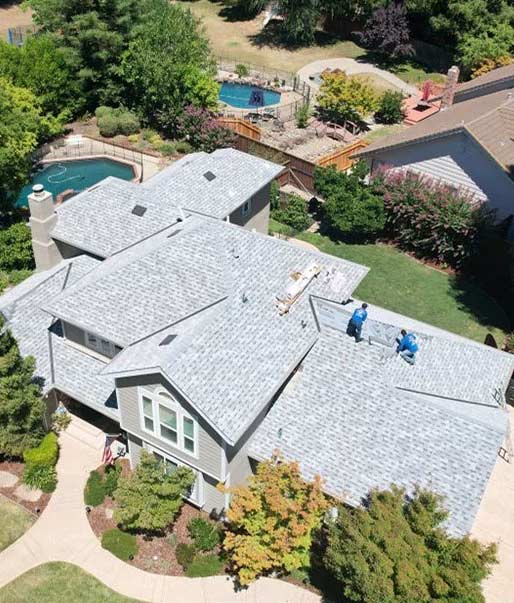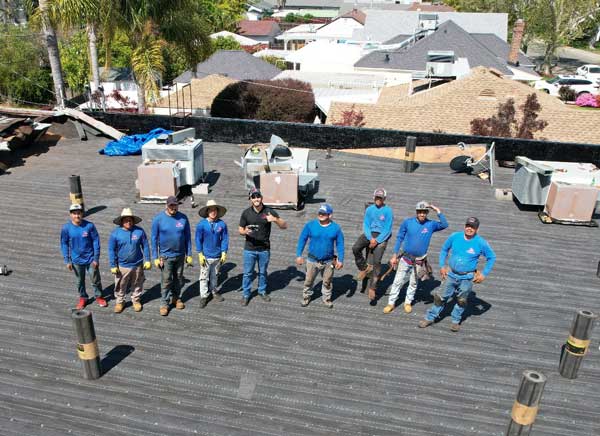Exploring the Benefits of Roof Replacement
Your roof is one of the most important aspects of your home’s structure, as it protects you and your family from the elements. However, many Stockton homeowners often neglect the condition of their roof until it’s too late. A damaged or outdated roof can cause a multitude of problems, including water damage, pest infestations, and energy loss. If you’re considering a roof replacement, this post is for you! In this article, we’ll explore the benefits of a new roof, including increased energy efficiency, improved curb appeal, and better protection against the elements. We’ll also discuss the different types of roofing materials available and what to consider when choosing the right one for your home. So, let’s raise the roof and dive into everything you need to know about roof replacement!
1. Signs that it’s time for a roof replacement
Recognizing the signs that indicate a roof replacement is necessary is crucial for maintaining the integrity and safety of your home. One of the most obvious signs is a consistent leakage issue, especially during heavy rain or snowfall. Water stains on the ceiling or walls, as well as mold or mildew growth, are clear indicators that your roof is no longer providing adequate protection.
Another key sign is the age of your roof. Most traditional asphalt shingle roofs have a lifespan of around 20-25 years. If your roof is nearing or has surpassed this age range, it may be time to consider a replacement to avoid potential structural damage and costly repairs down the line.
Furthermore, missing, cracked, or curling shingles are also red flags that your roof may need attention. Shingles that are deteriorating or losing their granules indicate that the protective layer of your roof is compromised, leaving it vulnerable to further damage from weather elements.
If you notice sagging areas or a noticeable decline in the overall appearance of your roof, it’s essential to have a professional inspection to assess the extent of the damage and determine if a replacement is necessary. Ignoring these signs can lead to more severe issues and pose safety risks to your home and its occupants.
2. The benefits of replacing your roof
Replacing your roof can bring a myriad of benefits that go beyond just aesthetic improvements. One of the key advantages of investing in a new roof is enhanced protection for your home. A new roof can provide better insulation, preventing leaks and potential water damage, ultimately increasing the longevity of your property.
Moreover, a new roof can significantly boost the curb appeal of your home. It can give your property a fresh and modern look, increasing its value and attracting potential buyers if you ever decide to sell. Aesthetically, a new roof can transform the entire appearance of your home, making it stand out in the neighborhood.
In addition, a new roof can also improve energy efficiency. With advancements in roofing materials and technologies, newer roofs are designed to reflect sunlight and reduce heat absorption, leading to lower energy bills and a more comfortable living environment.
Furthermore, investing in a new roof can provide peace of mind. Knowing that your home is well-protected from the elements and that you won’t have to worry about constant repairs and maintenance can significantly reduce stress and increase overall satisfaction with your living space.
Overall, the benefits of replacing your roof extend far beyond the surface level, offering improved protection, aesthetics, energy efficiency, and peace of mind for homeowners.
3. Choosing the right roofing materials
Choosing the right roofing materials is a crucial decision when considering a roof replacement. The material you select will not only impact the aesthetics of your home but also its durability, energy efficiency, and maintenance requirements. The local seasonal weather conditions in your Stockton neighborhood should also be considereed.
There is a wide range of roofing materials available, each with its own set of benefits and considerations. Asphalt shingles are a popular choice due to their affordability and variety of colors and styles. Metal roofing offers durability and longevity, while clay or concrete tiles provide a more traditional and elegant look.
When selecting roofing materials, it is essential to consider factors such as the climate in your area, the slope of your roof, and your budget. Certain materials may be better suited to withstand harsh weather conditions, while others may require more frequent maintenance.
Additionally, choosing energy-efficient roofing materials can help reduce your heating and cooling costs over time. Reflective materials can deflect sunlight and keep your home cooler in the summer, while insulating materials can help retain heat during the winter months.
Ultimately, the right roofing materials will not only enhance the curb appeal of your home but also provide long-term protection and energy savings. It is advisable to consult with a professional roofing contractor to determine the best materials for your specific needs and budget.
4. Hiring a professional roofer vs. DIY
When it comes to replacing your roof, the age-old debate of hiring a professional roofer versus tackling the project yourself often arises. While the DIY approach may seem appealing for its cost-saving potential, there are several key factors to consider before making a decision.
Professional roofers bring a wealth of experience, expertise, and specialized tools to the table, ensuring that the job is done efficiently and to a high standard. They are well-versed in navigating potential challenges that may arise during the replacement process, such as identifying underlying issues and ensuring proper installation techniques are employed.
On the other hand, opting for a DIY roof replacement may seem like a way to cut costs, but it comes with its own set of risks. Without the proper training and equipment, the quality of the work may not meet industry standards, leading to potential safety hazards and future issues that could end up costing more in the long run.
Ultimately, the decision between hiring a professional roofer and DIY comes down to your comfort level with the project, the complexity of the job, and your budget. While a DIY approach may be suitable for minor repairs or maintenance tasks, investing in a professional roofer for a full roof replacement can provide peace of mind and ensure a durable and long-lasting result for your home.
5. The cost of roof replacement
When considering roof replacement, one of the primary factors that homeowners need to take into account is the cost. Roof replacement costs can vary significantly depending on various factors such as the size of the roof, the materials used, the complexity of the design, and the contractor’s rates.
It is essential to obtain quotes from multiple reputable roofing contractors to compare prices and services offered. While cost is a crucial consideration, it is equally important to prioritize quality and expertise when choosing a roofing contractor. Cutting corners on costs may result in subpar workmanship and could end up costing more in the long run due to necessary repairs or premature replacement.
Additionally, homeowners should explore financing options or payment plans if the upfront cost of roof replacement is a concern. Some roofing companies offer financing options to help homeowners manage the expense of a new roof over time.
Investing in a high-quality roof replacement is a worthwhile endeavor that can enhance the aesthetics, functionality, and value of your home. By understanding the cost factors involved and making informed decisions, homeowners can ensure a successful roof replacement project that provides long-lasting benefits.
6. Understanding the roof replacement process
Understanding the roof replacement process is crucial for anyone considering this significant home improvement project. Roof replacement is a substantial investment that can have a lasting impact on the overall value, aesthetics, and functionality of your home.
The process typically begins with a thorough evaluation of the current roof to assess its condition and determine the extent of any damage or issues. This inspection will help determine whether a full replacement is necessary or if repairs may suffice.
Once the decision for a replacement is made, the next step involves choosing the right materials for your new roof. There are various options available, including asphalt shingles, metal roofing, tile, and more. Each material has its own benefits in terms of durability, longevity, and aesthetics, so it’s essential to select the one that best fits your needs and budget.
After selecting the materials, the actual replacement process begins with removing the old roof. This involves stripping away the existing shingles or tiles, inspecting the underlying structure for any damage, and making necessary repairs. The new roofing material is then installed, along with any additional components such as underlayment, flashing, and ventilation systems.
Throughout the process, it’s important to work with experienced and reputable roofing contractors to ensure the job is done correctly and efficiently. Proper installation is key to the longevity and performance of your new roof, so choosing a qualified professional is essential.
By understanding the roof replacement process and working with trusted professionals, you can ensure a successful and beneficial home improvement project that enhances the beauty, value, and protection of your home.
7. Energy efficiency and sustainability benefits
When considering a roof replacement, it’s essential to look beyond just aesthetics and functionality. One significant aspect to take into account is the energy efficiency and sustainability benefits that come with a new roof. Modern roofing materials are designed to enhance energy efficiency, helping you save on heating and cooling costs in the long run.
By investing in a new, energy-efficient roof, you can improve the insulation of your home, reducing heat loss in the winter and heat gain in the summer. This not only leads to a more comfortable indoor environment but also lowers your utility bills, making it a cost-effective choice in the long term.
Moreover, sustainable roofing options such as cool roofs or green roofs can further enhance your home’s eco-friendliness. Cool roofs reflect sunlight and absorb less heat, reducing the urban heat island effect and lowering energy consumption for cooling. On the other hand, green roofs provide natural insulation, absorb rainwater, and create a habitat for plants and wildlife, contributing to improved air quality and biodiversity.
In summary, opting for a roof replacement with energy-efficient and sustainable features can not only benefit your wallet but also contribute to a greener and healthier environment. It’s a win-win situation that adds value to both your home and the planet.
8. Increasing the value of your home with a new roof
Upgrading your roof can significantly increase the value of your home. A new roof not only enhances the aesthetic appeal of your property but also adds to its overall market value. Potential buyers are often willing to pay more for a home with a newly installed roof, as it indicates that they won’t have to worry about costly repairs or replacements in the near future.
Moreover, a new roof can improve the energy efficiency of your home, leading to lower utility bills. Modern roofing materials are designed to provide better insulation, reducing heat loss in the winter and heat gain in the summer. This can make your home more comfortable to live in and more attractive to prospective buyers.
In addition, a new roof can enhance the curb appeal of your home, making it stand out in the neighborhood. A visually appealing roof can make a strong first impression and draw more interest from potential buyers. Investing in a new roof is not just about maintaining the structural integrity of your home; it’s also a smart financial decision that can increase the value of your property in the long run.
9. How a new roof can improve curb appeal
A new roof can significantly enhance the curb appeal of your home, making it more attractive and appealing to both residents and visitors alike. The roof is one of the most prominent features of any house and plays a crucial role in defining its overall aesthetic appeal. By investing in a new roof, you can instantly transform the look of your home and elevate its exterior appearance.
Whether you opt for a classic shingle roof, a sleek metal roof, or a modern tile roof, the material and style you choose can greatly impact the curb appeal of your property. A new roof can give your home a fresh, updated look, increasing its visual appeal and making it stand out in the neighborhood.
Furthermore, a new roof can also increase the value of your home. Potential buyers are often drawn to properties with newly installed roofs, as they signify that the home has been well-maintained and is in good condition. By improving the curb appeal of your home with a new roof, you can attract more buyers and potentially fetch a higher price if you decide to sell in the future.
In addition to enhancing the aesthetic appeal and value of your home, a new roof can also boost its energy efficiency and structural integrity. Modern roofing materials are designed to provide better insulation and ventilation, helping to regulate indoor temperatures and reduce energy costs. A sturdy, well-maintained roof can also protect your home from weather damage and leaks, ensuring that it remains safe and secure for years to come.
Overall, investing in a new roof is a smart decision that can yield numerous benefits for your home. Not only does it improve curb appeal and increase property value, but it also enhances energy efficiency and extends the lifespan of your home’s structure. Consider upgrading your roof to give your home a fresh, stylish look and enjoy the many advantages that come with a quality roof replacement.
10. Maintaining and caring for your new roof
After investing in a new roof, it’s crucial to prioritize its maintenance and care to ensure its longevity and performance. Regular maintenance not only safeguards your investment but also enhances the overall efficiency and lifespan of your roof.
One of the key aspects of maintaining a new roof is conducting routine inspections. By inspecting your roof regularly, you can identify any potential issues such as leaks, damaged shingles, or clogged gutters before they escalate into major problems. Addressing these issues promptly can prevent costly repairs down the line.
In addition to inspections, it’s essential to keep your roof clean and free of debris. Clearing leaves, branches, and other debris from your roof and gutters can prevent water buildup and potential water damage. Regularly cleaning your roof will also help maintain its appearance and curb appeal.
Furthermore, consider scheduling professional roof maintenance at least once a year. A professional roofing contractor can assess the condition of your roof, make any necessary repairs, and provide valuable insights on how to prolong the life of your roof.
By staying proactive and diligent in maintaining and caring for your new roof, you can enjoy its benefits for years to come while protecting your home and investment.
In conclusion, we’ve explored the numerous benefits of roof replacement in this article. A new roof not only enhances the aesthetic appeal of your home but also provides crucial protection against the elements. Investing in a roof replacement can increase the value of your property, improve energy efficiency, and offer peace of mind knowing your home is secure. We hope this guide has shed light on the importance of maintaining a sturdy, reliable roof for your property. Remember, a solid roof is the foundation of a safe and comfortable home.








